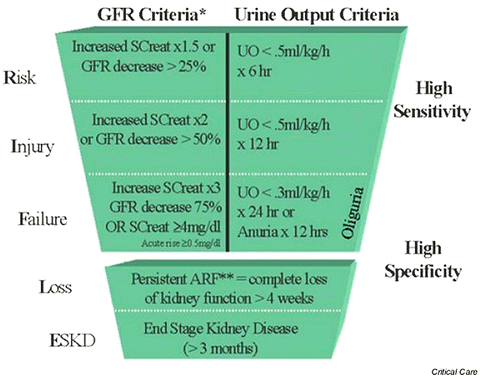Creatinine clearance or glomerular filtration rate (GFR) can be estimated with the Cockroft–Gault equation, where:
 Acute renal failure has also been staged according to the mnemonic RIFLE, proposed by Acute Dialysis Quality Initiative (ADQI) group, as in Fig. 15.1.
Acute renal failure has also been staged according to the mnemonic RIFLE, proposed by Acute Dialysis Quality Initiative (ADQI) group, as in Fig. 15.1.



Fig. 15.1
Stages of acute renal failure according to the RIFLE classification. ESKD end stage kidney disease, UO urinary output, ARF acute renal failure (Taken from Crit Care. 2004;8:R204–12 (DOI 10.1186/cc2872))
Pharmacokinetics
Renal impairment can affect drug handling by the body in more than one way. It can affect drug absorption, drug distribution, metabolism and excretion.
Absorption
Drug absorption can be reduced due to delayed gastric emptying typically observed in patients with renal disease, especially end stage renal disease. Gastrointestinal symptoms such as vomiting and diarrhea can also affect drug absorption. Due to fluid retention in renal failure, edema of the gastrointestinal tract can also affect drug absorption. Patients with chronic renal failure might be on oral alkalizing agent (sodium bicarbonate, citrate) or antacids and these can cause decreased absorption of oral drugs that require an acidic environment (see Chap. 3).
Distribution
Renal impairment can affect drug distribution due to changes in extracellular fluid (ECF) volume, plasma protein binding and also tissue binding of drugs. Water soluble drugs are distributed in the ECF volume, hence an increase in the ECF associated with renal failure might result in requirement for an increased loading dose of water soluble drugs to produce the desired effect (see Chap. 4). Renal impairment can lead to metabolic acidosis and this can also alter tissue distribution of drugs.
The effect of a drug is attributed to the free fraction of the drug which is unbound from plasma protein. In renal disease, acidic drugs have decreased protein binding (usually to albumin) whereas basic drugs are usually unchanged or decreased. This effect is particularly important for drugs that are highly protein bound (>80%). The decrease in albumin or plasma protein binding can be attributed to the following causes:
(a)
In the presence of uremia, plasma protein binding of acidic drugs is decreased. Most of the acidic drugs bind to albumin. It has been postulated that in the presence of renal disease with uremia, there might be displacement of drugs from albumin binding sites by organic molecules that accumulate in renal failure. The free fraction of highly protein bound drugs will increase and this may lead to drug toxicity.
(b)
Renal failure can lead to albumin loss (nephrotic state), decreasing the amount of albumin available to bind to drugs which will lead to an increase in free fraction of the drugs. This is especially important in highly protein bound drugs such as phenytoin.
(c)
Renal disease can also lead to a hypermetabolic state which can lead to increase protein breakdown (especially in stress, trauma or sepsis).
(d)
Renal impairment can also cause structural changes in albumin preventing acidic drug from binding to it.
Hence, the decrease in protein binding can lead to increases in free fraction of drugs, resulting in a potential to cause drug toxicity (see Chaps. 4 and 10).
Stay updated, free articles. Join our Telegram channel

Full access? Get Clinical Tree


